RIIT Report Series No.1
Sho HANEDA (RIIT Research Fellow)
Transportation strategy: Air and sea transportation
After the turn of the year, many exporting firms have been facing the issue with a mode of transportation due to an epidemic of the COVID-19. According to Bloomberg (2020), aviation companies tried to use passenger seats for transporting medical supplies, especially medical masks, in March 2020. Generally, they tend not to choose such strategies. However, the reduction in the number of travelers because of the spread of the COVID-19 may force them to change their business maneuvers.
In the context of the epidemic of the COVID-19, trading companies are highly likely to be required to choose air transportations to export time-sensitive products, even for traded goods that are transported by sea shipping under normal circumstances. Thus, it is important to investigate the Japanese transportation strategy in order to facilitate trade during the pandemic.
This short report explores the characteristics of Japanese transportation strategy using official monthly trade statistics by transportation modes in March 2020 to add relevant facts to RIIT report No 3 (in Japanese)
Recovery from February
As Figure 1 and Figure 2 illustrate, Japanese international trade by both air and sea transportations has recovered from its reduction in February, except for export by air transportation. However, each export and import value is lower compared to the same month last year, which indicates that Japan’s trade seems to be still in the process of full recovery.
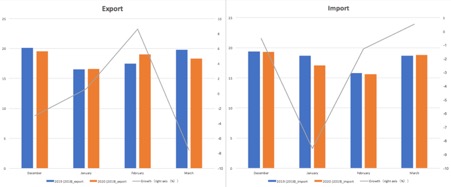
Source: Author’s calculation using Trade Statistics of Japan.
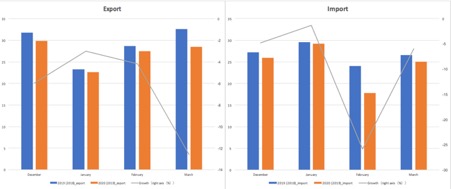
Source: Author’s calculation using Trade Statistics of Japan.
Figure 3 summarises the change in the Air-Sea transportation ratio, which is the proportion of the trade value of air transportation to that of sea transportation. The Air-Sea transportation ratio decreased in both exports and imports in March. Also, the ratio diminished for the case of exports while Japanese imports tend to shift from sea transportation to air transportation compared with the corresponding month last year. The next section explains the feature of Japanese international trade with China, which is one of the biggest of Japan’s trade partners.
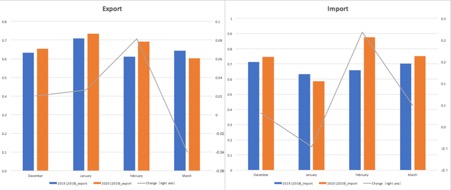
Source: Author’s calculation using Trade Statistics of Japan.
Note: Assuming that trade value by sea transportation is 1, the left axis means the value of trade by air transportation.
Trade with China demonstrates an upward trend
China started to resume the production of many manufacturing products after the drastic reduction of the number of victims of the COVID-19. For such occasions, Japanese international trade with China also recovered in March 2020 (Figure 4 and Figure 5). More importantly, compared to the same month last year, the air transportations are growing whereas sea transportation seems to be decreasing. The fact also can be seen in Figure 6.

Source: Author’s calculation using Trade Statistics of Japan.
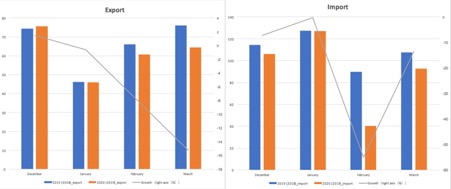
Source: Author’s calculation using Trade Statistics of Japan.
The characteristics of the Air-Sea transportation ratio are summarised in Figure 6. As mentioned above, the Air-Sea transportation ratio for both exports and imports in March increased over last year. Those facts support that some exporting firms might change their transportation strategy from sea transportation to air transportation. More detailed analyses need to be conducted to investigate what type of product is traded by air transportation in a period of crisis.
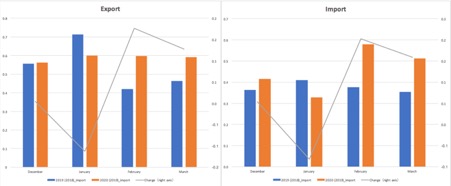
Source: Author’s calculation using Trade Statistics of Japan.
Note: Assuming that trade value by sea transportation is 1, the left axis means the value of trade by air transportation.
Facilitating international trade during a global pandemic
The short report overviews the feature of Japanese international trade with a focus on transportation modes. It finds that Japan’s trade tends to intergrade its transportation method into air transports under the circumstance of the epidemic of COVID-19. The results also imply that the decrease in the air freight tonnage may lead to the reduction in trade values, or even the disappearance of international trade. Thus, it should be noted that the government in each country needs to maintain the volume of airfreights by implementing policies or easing of regulations during a pandemic outbreak.
Reference
Bloomberg (2020). Desperate Airlines Swap Passengers for Cargo to Stay Afloat, Business article, March 26, 2020.

